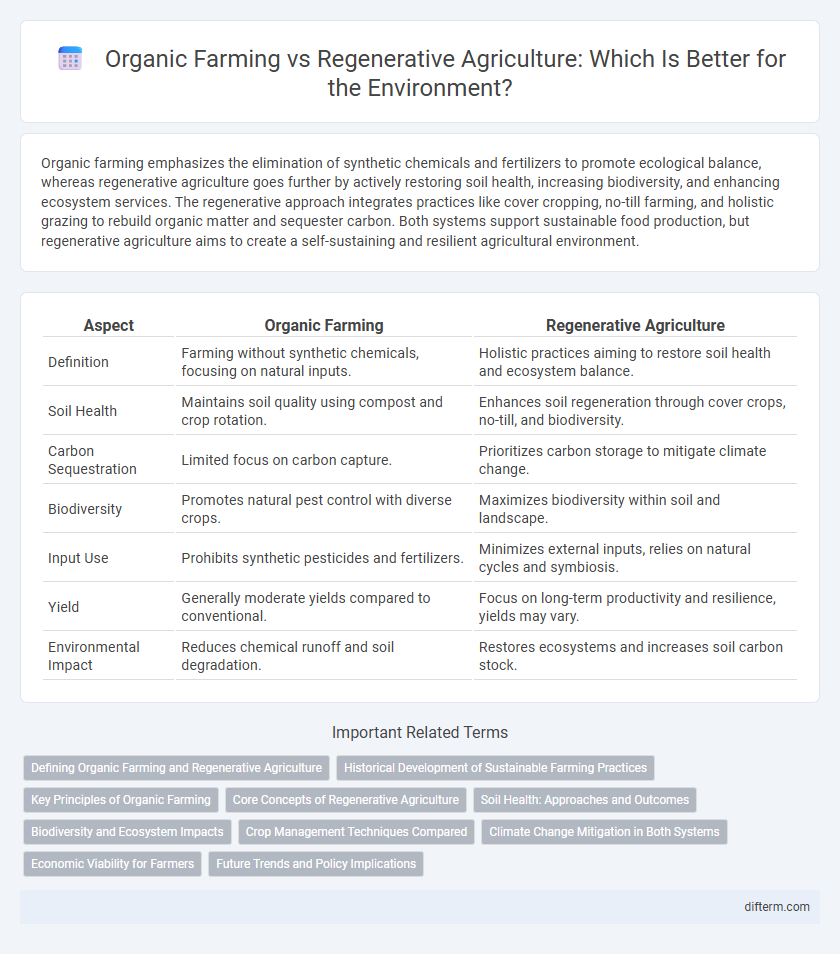Organic farming emphasizes the elimination of synthetic chemicals and fertilizers to promote ecological balance, whereas regenerative agriculture goes further by actively restoring soil health, increasing biodiversity, and enhancing ecosystem services. The regenerative approach integrates practices like cover cropping, no-till farming, and holistic grazing to rebuild organic matter and sequester carbon. Both systems support sustainable food production, but regenerative agriculture aims to create a self-sustaining and resilient agricultural environment.
Table of Comparison
| Aspect | Organic Farming | Regenerative Agriculture |
|---|---|---|
| Definition | Farming without synthetic chemicals, focusing on natural inputs. | Holistic practices aiming to restore soil health and ecosystem balance. |
| Soil Health | Maintains soil quality using compost and crop rotation. | Enhances soil regeneration through cover crops, no-till, and biodiversity. |
| Carbon Sequestration | Limited focus on carbon capture. | Prioritizes carbon storage to mitigate climate change. |
| Biodiversity | Promotes natural pest control with diverse crops. | Maximizes biodiversity within soil and landscape. |
| Input Use | Prohibits synthetic pesticides and fertilizers. | Minimizes external inputs, relies on natural cycles and symbiosis. |
| Yield | Generally moderate yields compared to conventional. | Focus on long-term productivity and resilience, yields may vary. |
| Environmental Impact | Reduces chemical runoff and soil degradation. | Restores ecosystems and increases soil carbon stock. |
Defining Organic Farming and Regenerative Agriculture
Organic farming emphasizes the use of natural inputs and practices to maintain soil fertility and avoid synthetic chemicals, prioritizing crop rotation, composting, and biological pest control. Regenerative agriculture goes beyond organic methods by actively restoring soil health, increasing biodiversity, and enhancing ecosystem services through techniques like cover cropping, no-till farming, and agroforestry. Both approaches aim to create sustainable agricultural systems but regenerative agriculture focuses more on long-term ecosystem resilience and carbon sequestration.
Historical Development of Sustainable Farming Practices
Organic farming emerged in the early 20th century as a response to the negative impacts of chemical-intensive agriculture, emphasizing natural inputs and soil health. Regenerative agriculture evolved later, building on organic principles by integrating practices that restore ecosystems, enhance biodiversity, and sequester carbon. Both approaches reflect a growing historical shift toward sustainable farming practices that prioritize long-term environmental resilience.
Key Principles of Organic Farming
Organic farming centers on key principles such as soil health, biodiversity, and the avoidance of synthetic chemicals to promote sustainable agriculture. It emphasizes natural processes like crop rotation, composting, and biological pest control to enhance ecosystem balance. These practices support long-term soil fertility and reduce environmental impact compared to conventional farming methods.
Core Concepts of Regenerative Agriculture
Regenerative agriculture centers on restoring soil health through practices like crop rotation, cover cropping, and reduced tillage, which enhance biodiversity and increase carbon sequestration. Unlike organic farming's emphasis on eliminating synthetic chemicals, regenerative methods prioritize ecosystem resilience and long-term productivity by rebuilding soil organic matter. Key principles include fostering symbiotic plant-microbe relationships and integrating livestock to create closed nutrient cycles that promote sustainable land stewardship.
Soil Health: Approaches and Outcomes
Organic farming emphasizes avoiding synthetic chemicals to maintain soil fertility, using crop rotation, compost, and natural pest control to promote microbial diversity and reduce soil degradation. Regenerative agriculture builds on these practices by integrating holistic methods like cover cropping, no-till farming, and agroforestry to enhance soil structure, increase carbon sequestration, and restore ecosystem balance. Both approaches improve soil health, but regenerative agriculture often achieves greater long-term resilience and biodiversity by actively rebuilding soil organic matter and nutrient cycles.
Biodiversity and Ecosystem Impacts
Organic farming enhances biodiversity by avoiding synthetic chemicals and promoting crop rotation, which supports soil health and beneficial insects. Regenerative agriculture goes further by restoring ecosystems through practices like cover cropping and holistic grazing, driving carbon sequestration and habitat regeneration. Both systems positively impact ecosystems, but regenerative agriculture emphasizes long-term resilience and ecosystem function restoration.
Crop Management Techniques Compared
Organic farming employs crop rotation, cover cropping, and natural pest management to maintain soil health and reduce chemical inputs. Regenerative agriculture enhances these practices by integrating no-till farming, diverse polycultures, and reintroduction of livestock to improve soil biodiversity and carbon sequestration. Both systems prioritize sustainable crop management but regenerative agriculture emphasizes restoring ecosystem functions beyond organic standards.
Climate Change Mitigation in Both Systems
Organic farming reduces greenhouse gas emissions by avoiding synthetic fertilizers and promoting soil carbon sequestration through natural inputs and crop rotations. Regenerative agriculture enhances climate change mitigation more effectively by restoring soil health, increasing biodiversity, and maximizing carbon capture through cover cropping, reduced tillage, and diverse plant systems. Both systems contribute to climate resilience, but regenerative agriculture offers a more holistic approach to long-term carbon storage and ecosystem balance.
Economic Viability for Farmers
Organic farming often involves higher labor costs and certification fees, which can reduce short-term profitability for farmers. Regenerative agriculture emphasizes soil health improvements and ecosystem services, potentially increasing long-term yields and reducing input costs, thereby enhancing economic viability. Market demand for sustainably produced goods further supports premium pricing for both farming practices, benefiting farmers' income stability.
Future Trends and Policy Implications
Regenerative agriculture emphasizes soil health restoration and carbon sequestration, positioning it as a crucial strategy in future climate resilience policies. Organic farming's strict regulations on synthetic inputs align with increasing consumer demand for pesticide-free produce, influencing upcoming agricultural standards. Governments are likely to integrate both practices into subsidy programs and environmental incentives to promote sustainable food systems and reduce greenhouse gas emissions.
organic farming vs regenerative agriculture Infographic

 difterm.com
difterm.com